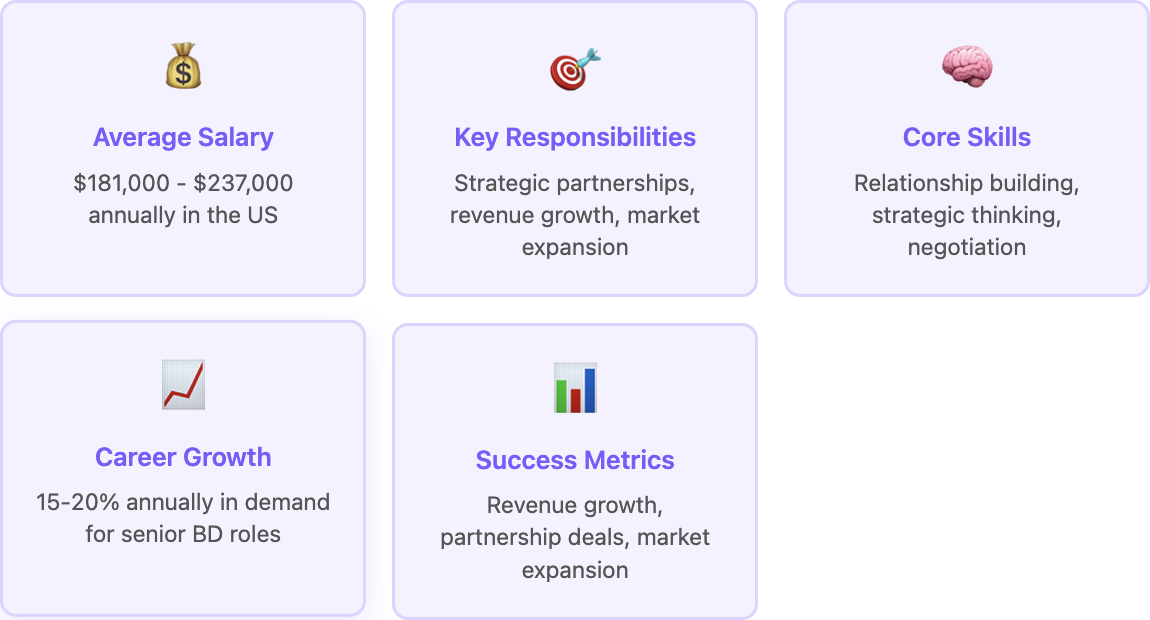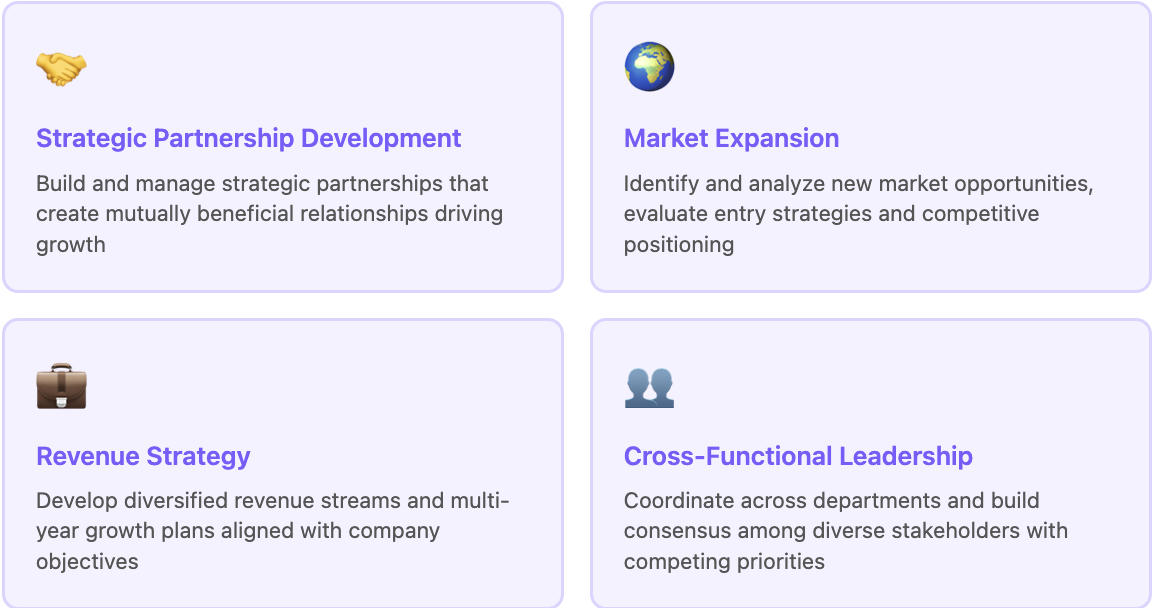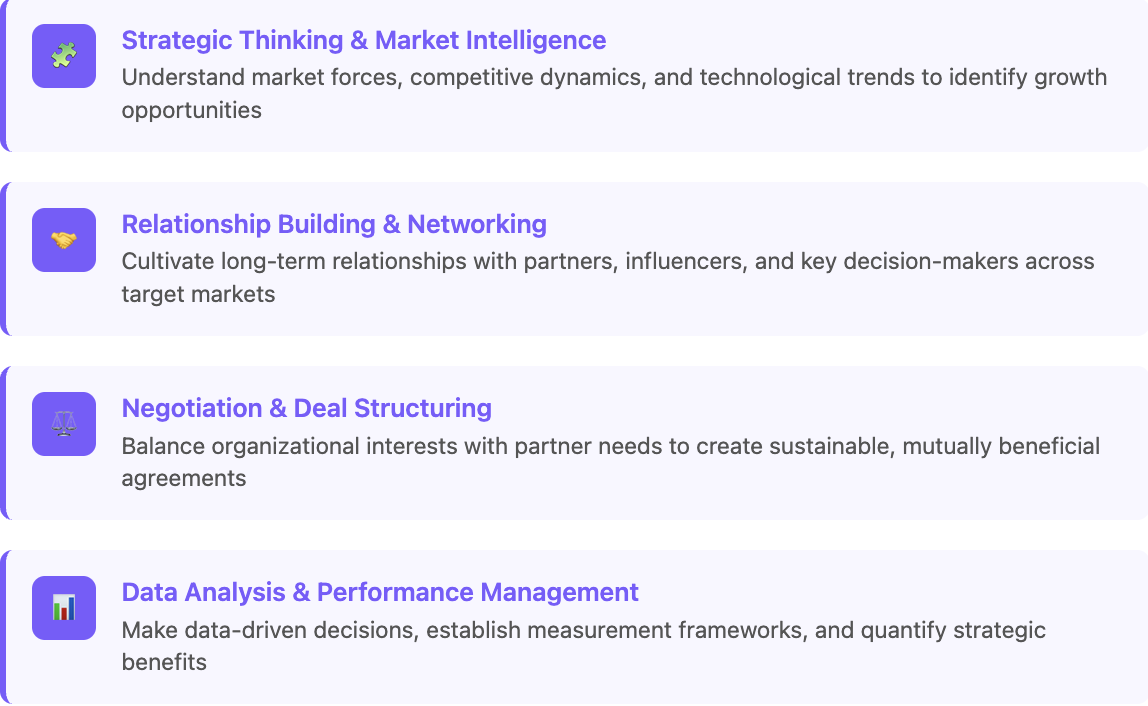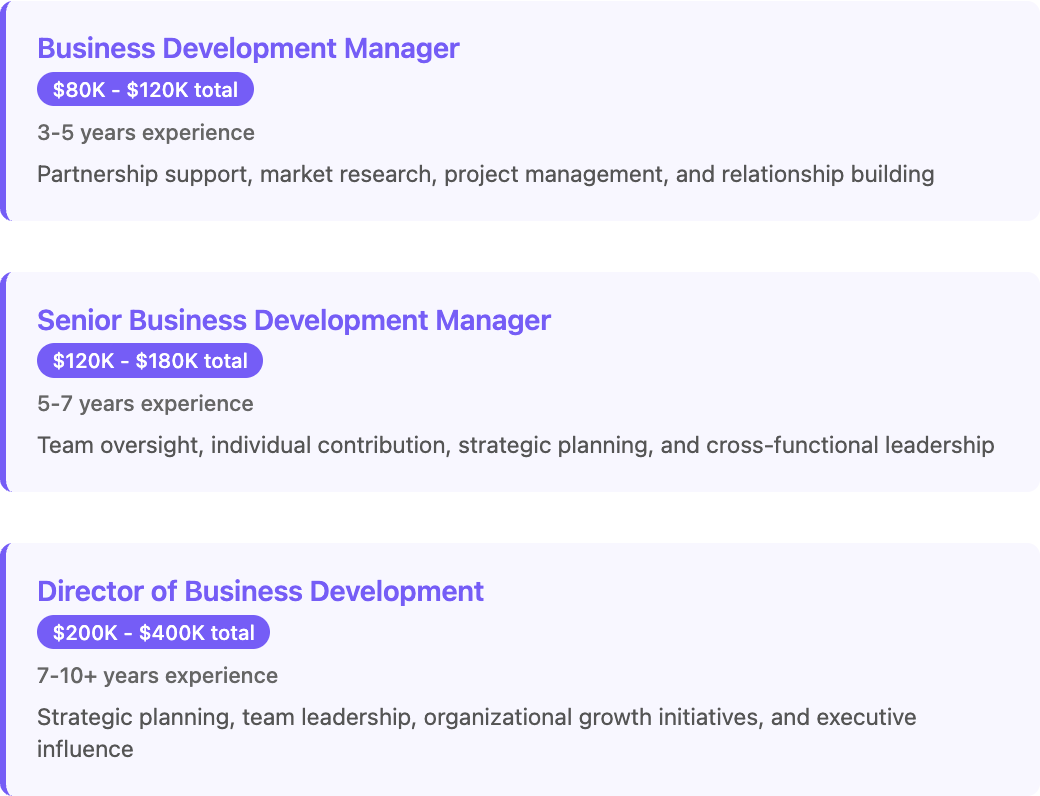Director of Business Development: Your Complete Guide to B2B Growth Leadership
How Directors of Business Development Drive Growth and Strategic Partnerships in B2B
Blogby JanAugust 05, 2025

The Director of Business Development role has become one of the most strategic positions in B2B companies, with professionals commanding six-figure salaries while driving organizational growth through partnerships and market expansion. Unlike traditional sales roles focused on closing individual deals, Directors of Business Development architect long-term growth strategies that can transform entire companies.
Recent data shows that companies with dedicated business development leadership grow 23% faster than those without, making this role increasingly critical for competitive advantage. Yet many organizations struggle to find qualified candidates who can balance strategic vision with execution excellence.

What Is a Director of Business Development?
A Director of Business Development serves as the strategic architect of a company's growth initiatives, focusing on identifying new market opportunities, building strategic partnerships, and creating sustainable revenue streams. This executive-level position goes far beyond traditional sales management to encompass market analysis, competitive intelligence, and cross-functional leadership.
The role sits at the intersection of strategy and execution, requiring professionals to think like entrepreneurs while operating within established organizational frameworks. Directors of Business Development typically report to C-level executives and often have significant influence over company direction and resource allocation.
Key distinguishing factors separate this role from other business positions. While sales directors focus on closing existing opportunities, business development directors create new opportunities. Where marketing directors generate awareness and leads, business development directors convert strategic relationships into revenue-generating partnerships. And unlike product managers who optimize existing offerings, business development directors identify entirely new markets and applications.
Core Responsibilities of a Director of Business Development
Strategic Partnership Development
Building and managing strategic partnerships represents the cornerstone of business development leadership. This involves identifying potential partners whose capabilities complement your organization's strengths, then structuring mutually beneficial relationships that drive growth for both parties.
Successful partnership development requires deep market knowledge and the ability to see connections that others miss. Directors must evaluate potential partners not just for their current capabilities, but for their strategic trajectory and cultural fit. The best partnerships create competitive advantages that neither organization could achieve independently.
Partnership management extends far beyond the initial agreement. Directors must establish governance structures, success metrics, and communication protocols to ensure partnerships deliver expected value. This often involves coordinating across multiple departments and managing complex stakeholder relationships.

Market Expansion and Opportunity Identification
Market analysis and expansion planning requires Directors to constantly scan the competitive landscape for emerging opportunities. This involves analyzing industry trends, studying competitor moves, and identifying gaps where their organization can create value.
Effective market expansion goes beyond simply entering new geographic regions. Directors must understand local market dynamics, regulatory requirements, and cultural nuances that could impact success. They often lead cross-functional teams to evaluate market entry strategies and resource requirements.
Opportunity qualification separates high-potential initiatives from resource drains. Directors develop frameworks for evaluating opportunities based on strategic fit, revenue potential, competitive positioning, and implementation feasibility. This analytical approach helps organizations focus limited resources on the highest-impact initiatives.

Revenue Strategy and Growth Planning
Revenue diversification represents a critical responsibility as companies seek to reduce dependence on single products, markets, or customer segments. Directors identify new revenue streams that leverage existing capabilities while opening pathways to sustainable growth.
Growth planning requires balancing ambitious targets with realistic execution timelines. Directors must understand their organization's capacity constraints while pushing teams to achieve stretch goals. This often involves developing multi-year roadmaps that sequence initiatives for maximum impact.
Performance measurement ensures growth strategies deliver expected results. Directors establish key performance indicators that track both leading indicators (like partnership agreements signed) and lagging indicators (like revenue generated). Regular performance reviews help teams course-correct when strategies aren't delivering expected outcomes.
Cross-Functional Leadership and Collaboration
Internal stakeholder management requires Directors to build consensus among diverse teams with potentially competing priorities. Product teams want to focus on existing offerings, while business development teams push for new applications. Finance teams demand predictable returns, while business development teams advocate for strategic investments with longer payback periods.
Successful Directors become internal advocates for growth initiatives, helping teams understand how new opportunities align with overall company objectives. This requires strong communication skills and the ability to translate strategic concepts into tactical actions that different departments can execute. Understanding Marketing Head responsibilities helps Directors align partnership strategies with broader marketing objectives and campaign execution.
Resource coordination involves securing necessary support from other departments without disrupting their core responsibilities. Directors must negotiate for product development resources, marketing support, and operational capacity while maintaining positive working relationships across the organization. This often requires close collaboration with Sales Operations teams who provide the infrastructure and processes supporting complex partnership initiatives.
Essential Skills for Directors of Business Development
Strategic Thinking and Market Intelligence
Strategic thinking distinguishes successful Directors from tactical executors. This involves understanding how market forces, competitive dynamics, and technological trends create opportunities for sustainable growth. Strategic thinkers can connect seemingly unrelated developments to identify emerging possibilities before competitors recognize them.
Market intelligence gathering requires both analytical skills and intuitive understanding of industry dynamics. Directors must synthesize information from multiple sources - industry reports, competitor analysis, customer feedback, and partner insights - to develop comprehensive market perspectives.
Competitive analysis helps Directors position their organizations advantageously within evolving market landscapes. This involves understanding not just direct competitors, but also substitute solutions and emerging technologies that could disrupt existing business models.

Relationship Building and Network Development
Relationship building forms the foundation of successful business development work. Directors must cultivate relationships with potential partners, industry influencers, and key decision-makers across their target markets. These relationships often take years to develop but can create significant competitive advantages.
Professional networking extends beyond collecting business cards at industry events. Successful Directors provide value to their networks through insights, introductions, and collaboration opportunities. This approach builds trust and credibility that supports long-term business development success.
Communication skills enable Directors to articulate complex value propositions to diverse audiences. They must explain technical capabilities to business audiences, translate market opportunities into financial projections, and present strategic recommendations to executive teams.
Negotiation and Deal Structuring
Negotiation expertise becomes critical when structuring partnerships and market entry agreements. Directors must balance their organization's interests with partner needs to create sustainable arrangements that deliver value for all parties.
Deal structuring involves understanding legal, financial, and operational implications of different partnership models. Directors work with legal and finance teams to create agreements that protect their organization's interests while enabling partners to achieve their objectives.
Risk assessment helps Directors identify potential challenges before they become problems. This involves evaluating partner financial stability, market risks, regulatory changes, and competitive threats that could impact partnership success.
Data Analysis and Performance Management
Data-driven decision making separates successful Directors from those who rely on intuition alone. Modern business development requires analyzing market data, partnership performance metrics, and competitive intelligence to make informed strategic decisions.
Performance management involves establishing measurement frameworks that track progress toward strategic objectives. Directors must identify leading indicators that predict future success and lagging indicators that measure actual results.
ROI analysis helps Directors prioritize initiatives and secure organizational support for growth investments. This requires understanding how to quantify both direct financial returns and strategic benefits that may not appear immediately in revenue numbers.
The Business Development Director Career Path

Entry-Level Progression
Business development careers typically begin with individual contributor roles focused on specific functions like lead generation, market research, or partnership support. These positions provide foundational experience in market analysis, relationship building, and project management.
SDR career development and Business Development Representatives often handle initial prospect outreach and qualification, learning to identify decision-makers and understand customer needs. This role develops essential communication skills and market knowledge that support career advancement.
Business Development Managers take on broader responsibilities including partnership development, market analysis, and cross-functional project leadership. This level requires demonstrated ability to manage complex initiatives and deliver measurable business results.
Mid-Level Management Roles
Senior Business Development Managers typically oversee teams while maintaining individual contribution responsibilities. This hybrid role develops leadership skills while ensuring continued market engagement and strategic thinking development.
Business Development Directors represent the first true executive level, with responsibility for strategic planning, team leadership, and organizational growth initiatives. This level requires proven ability to drive significant business results and influence cross-functional teams.
Regional or Divisional Directors manage business development across larger organizational units, requiring skills in resource allocation, team development, and strategic coordination across multiple markets or product lines.
Executive Leadership Positions
Vice Presidents of Business Development typically oversee enterprise-wide growth strategies and may have multiple directors reporting to them. This level requires demonstrated ability to scale business development processes and deliver consistent growth results.
Chief Business Development Officers represent the highest level of business development leadership, with responsibility for organizational growth strategy and partnership with other C-level executives. These roles require proven track records of transformational growth achievement.
Chief Sales Officer and Chief Revenue Officers often combine sales, marketing, and business development responsibilities under unified revenue leadership. This evolution reflects the increasing integration of growth functions in modern organizations.
Salary and Compensation Expectations
Base Salary Ranges by Experience Level
Entry-level Directors with 3-5 years of business development experience typically earn base salaries between $120,000 and $150,000 annually. These positions often include significant variable compensation opportunities based on performance metrics.
Mid-level Directors with 5-10 years of experience command base salaries ranging from $150,000 to $200,000, with total compensation packages often reaching $250,000 to $300,000 when including bonuses and equity participation.
Senior Directors with 10+ years of experience and proven track records of driving significant growth can earn base salaries exceeding $200,000, with total compensation packages reaching $400,000 or more in high-growth technology companies.

Variable Compensation and Incentives
Performance bonuses typically represent 20-40% of total compensation for Directors of Business Development. These bonuses are usually tied to specific metrics like revenue growth, partnership deals closed, or market expansion achievements.
Equity participation becomes increasingly common at director level and above, particularly in growth-stage companies where business development leadership directly impacts company valuation. Stock options or restricted stock awards align Director interests with long-term company success.
Commission structures vary significantly by industry and company stage. Some organizations offer commission on partnership-generated revenue, while others focus on fixed bonuses for achieving strategic milestones.
Geographic and Industry Variations
Geographic differences significantly impact compensation levels. Directors in major metropolitan areas like San Francisco, New York, and Boston typically earn 20-30% more than those in smaller markets, reflecting cost of living differences and talent competition.
Industry premiums exist for sectors like technology, biotechnology, and financial services where business development directors create particularly high value. These industries often offer total compensation packages 30-50% above average levels.
Company stage also influences compensation approaches. Startups may offer lower base salaries but higher equity upside, while established enterprises typically provide higher guaranteed compensation with more modest variable components.
Common Challenges Directors Face
Long Sales Cycles and Complex Decision-Making
Extended sales cycles represent one of the most significant challenges in B2B business development. Strategic partnerships and market expansion initiatives often require 12-18 months from initial contact to signed agreements, testing Director patience and organizational commitment.
Multiple stakeholder management complicates decision-making processes as Directors must navigate various internal and external stakeholders with different priorities and concerns. Success requires building consensus among diverse groups while maintaining momentum toward strategic objectives.
Resource allocation during long sales cycles can strain organizational patience and budget commitments. Directors must demonstrate progress and value creation even when final outcomes remain months away.
Market Competition and Differentiation
Competitive pressure intensifies as markets mature and competitors recognize the same opportunities. Directors must continuously evolve value propositions and partnership approaches to maintain competitive advantages.
Commoditization risks emerge when market offerings become standardized and price-focused. Directors must identify ways to create unique value that justifies premium positioning and protects profit margins.
Market saturation in established segments forces Directors to explore adjacent markets or develop innovative approaches to reach underserved customer segments.
Internal Alignment and Resource Constraints
Cross-functional coordination challenges arise when business development initiatives require support from product, marketing, operations, and finance teams already focused on core business activities.
Budget constraints limit Director ability to pursue all attractive opportunities, requiring difficult prioritization decisions and creative resource utilization approaches.
Cultural resistance to new market or partnership approaches can slow implementation of business development strategies, particularly in organizations with strong existing business models.
How Databar Solves Business Development Challenges
While Directors of Business Development face numerous operational challenges, modern data enrichment platforms like Databar transform how business development teams identify, research, and engage with potential partners and prospects.
Comprehensive Market Intelligence
Traditional market research requires weeks of manual effort to identify potential partners, analyze competitive landscapes, and understand market dynamics. Databar's integrated approach provides Directors with comprehensive market intelligence through automated data enrichment across 90+ sources.
Instead of manually researching each potential partner company, Directors can automatically enrich entire market segments with firmographic data, technographic insights, funding information, and key personnel details. This comprehensive view enables more strategic partnership decisions based on complete information rather than limited research.
Real-time market monitoring keeps Directors informed about changes in target markets, including new funding rounds, executive changes, technology adoptions, and competitive moves that could represent partnership opportunities or threats.
Strategic Partnership Research and Qualification
Partnership qualification traditionally consumes significant Director time as teams manually research potential partners, identify decision-makers, and gather intelligence needed for effective outreach approaches.
Databar streamlines this process by providing complete company profiles including recent news, funding status, technology stack, employee growth trends, and key personnel information. Directors can quickly evaluate partnership fit and prioritize outreach efforts based on comprehensive data rather than limited public information.
Automated contact enrichment ensures Directors have verified contact information for key decision-makers at target partner organizations. Instead of spending time hunting for email addresses and phone numbers, teams can focus on crafting compelling partnership proposals and building relationships.
Data-Driven Relationship Building
Relationship building effectiveness improves dramatically when Directors have comprehensive context about potential partners, their challenges, recent achievements, and strategic priorities.
Databar's AI-powered insights help Directors personalize outreach based on recent company news, technology adoptions, funding announcements, and other contextual information that demonstrates understanding of partner priorities and challenges.
Social media and professional network analysis reveals mutual connections and relationship pathways that can facilitate warm introductions and accelerate relationship development processes.
Performance Measurement and Optimization
Partnership pipeline management requires tracking numerous opportunities across different stages of development while maintaining visibility into key performance metrics and success factors.
Databar's comprehensive enrichment enables Directors to maintain detailed profiles of all partnership opportunities, track engagement history, and analyze patterns that predict successful partnership outcomes.
Automated data updates ensure partnership information remains current as companies evolve, preventing Directors from pursuing outdated opportunities or missing new developments that could impact partnership potential.
Building a Successful Business Development Strategy
Market Analysis and Opportunity Identification
Effective market analysis begins with comprehensive data gathering about target markets, competitive landscapes, and potential partnership opportunities. Directors must understand market size, growth trends, key players, and emerging opportunities that align with their organization's capabilities.
Opportunity scoring frameworks help Directors prioritize potential initiatives based on strategic fit, revenue potential, competitive intensity, and implementation requirements. These frameworks ensure limited resources focus on the highest-impact opportunities.
Market segmentation enables Directors to develop targeted approaches for different customer types, geographic regions, or application areas. Segmented strategies typically deliver better results than broad-based approaches that try to address all opportunities simultaneously.
Partnership Strategy Development
Partnership portfolio management requires balancing different types of relationships to create synergistic effects. This might include technology partnerships that enhance product capabilities, channel partnerships that expand market reach, and strategic alliances that create competitive advantages.
Partner qualification criteria help Directors identify organizations that align with strategic objectives and possess complementary capabilities. Clear qualification criteria prevent resource waste on partnerships unlikely to deliver expected value.
Partnership lifecycle management involves different approaches for partnership development, launch, growth, and renewal phases. Understanding these lifecycle dynamics helps Directors allocate resources appropriately and set realistic timeline expectations.
Revenue Planning and Growth Metrics
Revenue attribution from business development activities can be complex when partnerships generate indirect value or long-term benefits. Directors must establish measurement frameworks that capture both direct revenue impact and strategic value creation.
Growth trajectory planning involves setting realistic but ambitious targets that stretch organizational capabilities while remaining achievable. Effective planning considers market dynamics, competitive factors, and internal resource constraints.
Performance dashboard development provides visibility into key metrics that predict business development success. Leading indicators might include partnership meetings scheduled, proposals submitted, and pilot projects initiated, while lagging indicators track revenue generated and market share gains.
Technology Tools for Modern Business Development
CRM and Pipeline Management
Customer relationship management systems provide the foundation for organized business development efforts. Modern CRM platforms enable Directors to track partnership opportunities, maintain contact histories, and coordinate team activities across complex sales cycles.
Pipeline management features help Directors understand opportunity progression, identify bottlenecks, and forecast revenue outcomes. Advanced CRM systems provide analytics that reveal patterns in successful partnerships and optimization opportunities.
Integration capabilities connect CRM systems with other business tools to create comprehensive views of partnership opportunities and their potential impact on organizational growth.
Data Enrichment and Market Intelligence
Automated data enrichment platforms like Databar transform how Directors gather and maintain information about potential partners, competitive landscapes, and market opportunities. These platforms eliminate manual research tasks while providing more comprehensive and current information.
Market intelligence tools aggregate information from multiple sources to provide Directors with insights about industry trends, competitive moves, and emerging opportunities. This intelligence helps Directors position their organizations advantageously and identify partnership possibilities before competitors.
Social media monitoring tools track mentions of target partners, competitors, and market developments to provide Directors with timely intelligence about market dynamics and relationship opportunities.
Communication and Collaboration Tools
Video conferencing platforms enable Directors to build relationships across geographic boundaries and maintain regular contact with partners throughout development processes. High-quality video communication often proves more effective than email or phone conversations for complex partnership discussions.
Collaboration platforms facilitate cross-functional teamwork required for successful business development initiatives. These tools help Directors coordinate activities across product, marketing, sales, and operations teams while maintaining visibility into project progress.
Document management systems ensure important partnership agreements, proposals, and strategic plans remain accessible to relevant team members while maintaining appropriate security controls.
Future Trends in Business Development Leadership
Digital Transformation Impact
Digital tools and platforms continue transforming how Directors identify opportunities, build relationships, and manage partnerships. Artificial intelligence and machine learning increasingly automate routine tasks while providing insights that enhance strategic decision-making.
Virtual relationship building capabilities enable Directors to build meaningful partnerships without extensive travel requirements. Digital tools are becoming sophisticated enough to support complex partnership negotiations and relationship management activities.
Data-driven insights provide Directors with market intelligence and performance metrics that were previously unavailable or required significant manual effort to compile. These insights enable more strategic and effective business development approaches.
Evolving Partnership Models
Ecosystem partnerships represent an emerging trend where companies create networks of complementary relationships rather than individual bilateral partnerships. Directors must develop skills in orchestrating complex multi-party relationships and managing ecosystem dynamics.
Subscription and recurring revenue models change how Directors structure partnerships and measure success. These models often require different approaches to partner enablement, support, and performance measurement.
Platform-based partnerships enable companies to leverage existing platforms and marketplaces for distribution and customer acquisition. Directors must understand platform dynamics and develop strategies that work within existing ecosystem constraints.
Skills and Competency Evolution
Technology fluency becomes increasingly important as Directors must understand how emerging technologies create partnership opportunities and competitive threats. This includes understanding artificial intelligence, automation, blockchain, and other technologies that impact business models.
Data analysis capabilities grow in importance as Directors gain access to more sophisticated market intelligence and performance measurement tools. The ability to extract insights from complex data sets becomes a key differentiating skill.
Cross-cultural competency increases in value as partnerships increasingly span geographic and cultural boundaries. Directors must develop skills in navigating different business cultures and regulatory environments to build successful international partnerships. As business development becomes more technical, understanding emerging roles like RevOps vs GTM Engineering helps Directors build effective partnerships with technical teams.
Measuring Business Development Success
Key Performance Indicators
Revenue metrics provide the most direct measurement of business development success, but Directors must also track leading indicators that predict future revenue generation. These might include partnership agreements signed, pilot projects initiated, and qualified opportunities in development.
Partnership quality metrics assess the strategic value of relationships beyond immediate revenue impact. Metrics might include partner satisfaction scores, joint marketing activities, and collaborative product development initiatives.
Market expansion indicators track progress in entering new markets or customer segments. These metrics help Directors understand whether business development efforts are successfully broadening organizational reach and reducing market concentration risks.
Return on Investment Analysis
Resource allocation tracking helps Directors understand which types of partnerships and market development activities generate the highest returns. This analysis guides future resource allocation decisions and strategy optimization efforts.
Time-to-value measurement tracks how long partnerships take to generate meaningful business impact. Understanding these timelines helps Directors set appropriate expectations and plan resource commitments effectively.
Strategic value quantification attempts to measure benefits that don't appear directly in revenue numbers, such as competitive advantages gained, market positioning improvements, and capability enhancements achieved through partnerships.
Continuous Improvement Processes
Performance review cycles provide opportunities to analyze what's working well and what needs improvement in business development approaches. Regular reviews help Directors adapt strategies based on market feedback and performance results.
Best practice identification involves analyzing successful partnerships and initiatives to understand success factors that can be replicated in future efforts. This institutional learning improves overall business development effectiveness over time.
Strategy optimization requires willingness to evolve approaches based on market feedback and performance results. The most successful Directors continuously refine their strategies rather than rigidly following predetermined plans.
FAQs
What qualifications do you need to become a Director of Business Development?
Most Director positions require a bachelor's degree in business, marketing, or a related field, plus 7-10 years of progressive business development or sales experience. Many Directors also hold MBA degrees, particularly those in technology or financial services sectors. Essential qualifications include proven track records of driving revenue growth, building strategic partnerships, and leading cross-functional teams. Industry expertise in your target sector often proves as valuable as formal education credentials.
How much do Directors of Business Development make?
Directors of Business Development typically earn between $150,000 and $250,000 in base salary, with total compensation ranging from $200,000 to $400,000 including bonuses and equity. Compensation varies significantly by geographic location, industry, and company size. Technology and biotechnology companies typically offer the highest compensation packages, while companies in smaller markets or traditional industries may offer lower but still competitive packages.
What's the difference between a Director of Business Development and a Sales Director?
Directors of Business Development focus on creating new market opportunities, building strategic partnerships, and identifying long-term growth strategies, while Sales Directors primarily manage existing sales processes and team performance to close deals. Business Development Directors work on longer-term initiatives that may take months or years to generate revenue, whereas Sales Directors focus on shorter-term revenue achievement through existing products and markets. Both roles are critical but require different skill sets and performance measurements.
What are the biggest challenges facing Directors of Business Development?
The primary challenges include managing long sales cycles that can extend 12-18 months, building consensus among multiple stakeholders with different priorities, and demonstrating ROI on initiatives that may not generate immediate revenue. Directors also face increasing competition for attractive partnership opportunities, resource constraints that limit ability to pursue all opportunities, and the need to balance strategic vision with tactical execution demands.
How do you transition into a Director of Business Development role?
Successful transitions typically require building a track record of business development success in manager or senior manager roles, developing strategic thinking capabilities beyond tactical execution, and demonstrating ability to influence cross-functional teams and senior executives. Many professionals benefit from expanding their network within target industries, pursuing additional education in strategic planning or business development, and seeking stretch assignments that provide exposure to partnership development and market expansion initiatives.
What skills are most important for Business Development Directors?
Critical skills include strategic thinking and market analysis capabilities, relationship building and networking expertise, negotiation and deal structuring abilities, and cross-functional leadership skills. Technical skills in data analysis, CRM systems, and market research tools are increasingly important. Soft skills like communication, influence, and cultural adaptability become essential for building partnerships across diverse organizations and markets.
How do you measure success as a Director of Business Development?
Success measurement typically combines revenue metrics (partnership-generated revenue, market expansion results), strategic metrics (number of strategic partnerships developed, new market segments entered), and operational metrics (partnership pipeline health, deal conversion rates). Many Directors also track qualitative measures like partner satisfaction, internal stakeholder alignment, and competitive positioning improvements. The key is establishing both leading and lagging indicators that predict and measure business development impact.
What industries offer the best opportunities for Business Development Directors?
Technology, biotechnology, financial services, and professional services typically offer the highest compensation and most dynamic partnership opportunities. However, opportunities exist across all industries as companies increasingly recognize the importance of strategic partnerships and market expansion. Emerging sectors like renewable energy, artificial intelligence, and digital health also offer significant growth opportunities for experienced business development professionals.
Related articles

Buying Signals & Intent Data: Why Your CRM Is Missing the 5 Accounts
Why Most Teams Miss Their Hottest Prospects (And How to Fix Your Signal Detection)
by Jan, October 06, 2025

Lead Scoring & Account Segmentation: Why Most CRMs Get This Backward (And How to Fix It)
How to build a system that tells your team who to call, when, and why
by Jan, October 06, 2025

The CRM Data Cleaning & Hygiene Playbook
Your Guide to A Clean & Up-To-Date Database
by Jan, October 04, 2025

Everything You Need To Know About CRM Enrichment
Your Step-By-Step Guide To CRM Data Enrichment
by Jan, October 03, 2025

